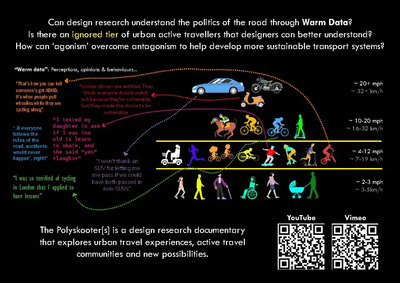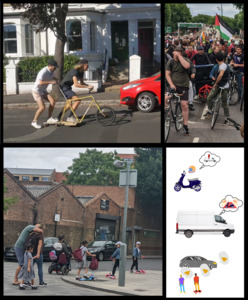The Polyskooter[s]
Preston, O. Fred (2022) The Polyskooter[s]. In: Proceedings of Relating Systems Thinking and Design, RSD11, 3-16 Oct 2022, Brighton, United Kingdom.
![Preston_Poly_2022.png [thumbnail of Preston_Poly_2022.png]](https://openresearch.ocadu.ca/4567/1.hassmallThumbnailVersion/Preston_Poly_2022.png)  Preview |
Image
Preston_Poly_2022.png Available under License Creative Commons Attribution Non-commercial No Derivatives. Download (657kB) | Preview |
![Preston_Poly_Img_2022.png [thumbnail of Preston_Poly_Img_2022.png]](https://openresearch.ocadu.ca/4567/2.hassmallThumbnailVersion/Preston_Poly_Img_2022.png)  Preview |
Image
Preston_Poly_Img_2022.png Available under License Creative Commons Attribution Non-commercial No Derivatives. Download (4MB) | Preview |
Abstract
Short Documentary Film: A story of stories curated to explore the embodied kinship that’s centred on “skooting” (rollerskating, skateboarding, scooter-ing & similar), bicycling and other forms of urban road and street travel.
Cultural systems are expressed in the structural design of streets and urban roads: a most immediate public space. They are reinforced by social infrastructure; the common interpretation of inevitable grey areas within rules, displayed in split-second judgements and movements. Evidence for this lies in tacit, experiential knowledge.
When tension arises between conflicting judgements (or “habitus”), entrenched hierarchies are defended using politicised rhetoric; one example being the “bicycles v cars” divide. This research began by mapping the warm data of trust/mistrust, the antagonistic/agonistic, found in storytelling.
The research progressed beyond established strata – via critical modality — to understand the in-betweens. “Polyskooters” represents active travel at speeds in-between pedestrians and cyclists. The Polyskooter meanwhile, is a speculative design to generate experiential, embodied understandings of skate and scoot community, using Critical Jugaad (make-shift design).
These hard-wheeled modes like skateboards, push-scooters or roller-skates exist on the messy fringes – quite literally – between pavement and road! Systems of visual storytelling, such as films or advertisements, rarely include these in liminal depictions. Yet, areas on the edge of ‘normal’ provide fertile ground for insights around how urban travel systems could incorporate such diverse, non-dominant situated realities — including others like mobility scooterers or tandem cyclists.
| Item Type: | Conference/Workshop Item (Other) |
|---|---|
| Divisions: | Faculty of Design |
| Date Deposited: | 07 Jun 2024 19:17 |
| Last Modified: | 07 Jun 2024 19:17 |
| URI: | https://openresearch.ocadu.ca/id/eprint/4567 |
Actions (login required)
 |
Edit View |

 Tools
Tools Tools
Tools